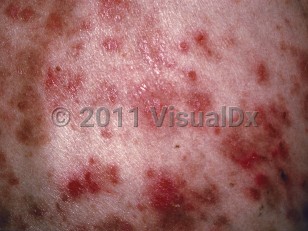Pemphigus foliaceus in Child
Alerts and Notices
Important News & Links
Synopsis

PF is associated with human leukocyte antigen (HLA) class II alleles DR1, DR4, and DR14. PF presents in two major forms: endemic (fogo selvagem) and sporadic. The endemic form primarily affects pediatric and young adults, whereas the sporadic form primarily affects middle-aged and older adults.
The endemic form of PF is primarily seen in Brazil, other parts of Latin America, and Tunisia. Pathogenesis is complex, involving genetic, environmental, and immunological factors. Environmental factors include the bite of some insects, such as the Simulium black fly (Simulium nigrimanum). With modern treatment, disease course is typically benign, but fulminant cases have rarely been reported.
Sporadic forms of PF have rarely been reported in children. Triggers in pediatric sporadic PF are similar to those in adults and include sun exposure and medication. Infectious causes have also been suggested but not proven. Prognosis of sporadic pediatric PF is typically good, with a short and benign course, although death related to the skin disease has been reported.
Pemphigus erythematosus (Senear-Usher syndrome), a subtype of PF that typically affects the malar region and may rarely affect the seborrheic areas, has also been reported in children but is typically seen in adults. Pemphigus erythematosus may coexist with other autoimmune disorders, such as myasthenia gravis or lupus erythematosus. Pemphigus erythematosus patients may progress to classic PF over time.
Codes
L10.2 – Pemphigus foliaceous
SNOMEDCT:
35154004 – Pemphigus foliaceus
Look For
Subscription Required
Diagnostic Pearls
Subscription Required
Differential Diagnosis & Pitfalls

Subscription Required
Best Tests
Subscription Required
Management Pearls
Subscription Required
Therapy
Subscription Required
Drug Reaction Data
Subscription Required
References
Subscription Required
Last Updated:07/27/2020

